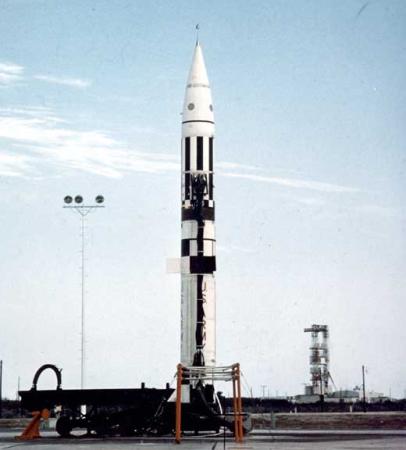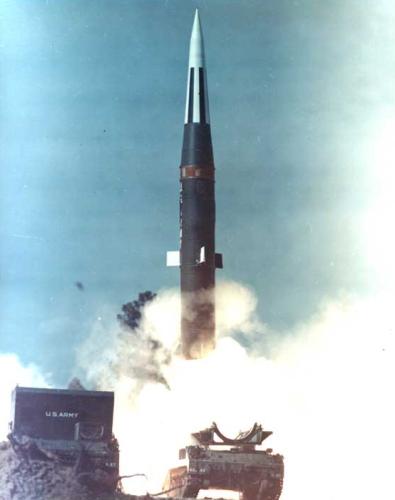Martin Marietta M14/MGM-31 Pershing
The MGM-31 Pershing was the first and only solid-fueled MRBM (Medium Range Ballistic Missile) deployed by the U.S. Army. It has been in service for almost 30 years until all nuclear MRBMs were phased out and destroyed according to arms reduction treaties.
Studies for a solid-fueled missile with a maximum range in the 900-1400 km (500-750 nm) area were begun by the U.S. Army in 1956. In 1957, the studies had shown that the proposed missile was feasible, and in the same year a temporary DOD restriction which limited the Army's missiles to a range of less than 320 km (200 miles) had been cancelled. In January 1958, the name Pershing was officially assigned to the new missile program, and in March that year Martin's Orlando division was awarded a full scale development contract. The Pershing was designed as a two-stage solid-fueled rocket with an all-inertial guidance system, to be fired from a mobile launcher. Development was quick, and in February 1960, the first Pershing I, designated Guided Missile XM14, was launched. The first test flights used only the first stage, but by the end of 1960, full range two stage flights had been successful. The first launch from the tactical missile launcher occurred in January 1962, and in June 1962 the first Pershing I unit received its first missiles. By 1964, the first battalions were deployed to their operating area in West Germany. The Pershing I quickly replaced all PGM-11 Redstone MRBMs.
 |
| Photo: U.S. Army |
| XM14 (XMGM-31A) |
The Pershing I was powered by two soild-fueled rochet stages by Thiokol (a TX-174 and a TX-175), and could carry its 400 kT W-50 thermonuclear warhead to a maximum range of 740 km (460 miles). It was guided by an inertial navigation system by Eclipse-Pioneer, and featured a high-speed ablative reentry vehicle. A single Pershing I launch platoon consisted of only 4 vehicles, compared to about 20 for the PGM-11 Redstone. Coupled with the solid-propellant rockets, this led to a much higher mobility and shorter reaction time than the Redstone it replaced. For training there was an inert Pershing I missile designated XM19.
In June 1963, the XM14 and XM19 Pershing missiles were redesignated as XMGM-31A and XMTM-31B, respectively. The production version of the tactical missile was subsequently designated as MGM-31A, and the XMTM-31B designation was apparently not used and eventually dropped form the list. The -31B suffix was later reused.
 |
| Photo: U.S. Army |
| MGM-31A |
In early 1965, the DOD issued a requirement for a QRA (Quick Reaction Alert) Pershing missile system, with the intention to replace the USAF's CGM//MGM-13 Mace missiles by the MGM-31. In January 1966, Martin Marietta was awarded a contract to develop the Pershing Ia system to meet this requirement. The Pershing Ia system consisted of faster ground support vehicles, a faster erector/launcher, and new solid-state electronics. The missiles compatible with the new system were designated MGM-31B. Production of the Pershing Ia began in 1967, and by 1970 it had replaced all original Pershing I systems in U.S. Army service.
In 1976, further improvements of the Pershing Ia system were fielded, the sequential launch adapter (SLA) and the automatic reference system (ARS). The SLA allowed a Pershing Ia platoon to fire its three missiles in quick succession, and the ARS (essentially a ground based inertial unit) eliminated the need to survey the launch site before firing, making on-the-spot launches possible. Production of the Pershing Ia was originally completed in 1975, but the line had to be reopened from 1977 to 1979 to replace missiles expended in training exercises. A total of about 750 Pershing I/Ia missiles were built, with an operational deployment level of 108 missiles in Europe.
 |
| Photo: U.S. Army |
| MGM-31B |
In the early 1970s, the 400 kT warhead of the Pershing Ia had become a problem, because it effectively excluded the use of the MGM-31 in its intended role of a tactical missile (except for the few LGM-25C Titan IIs, all strategic missiles of the time had less powerful warheads!). Therefore it was decided to develop a new warhead section for Pershing, with a lower yield warhead and a high-accuracy manoeuvering reentry vehicle (MARV) with active radar terminal guidance. The new missile was named Pershing II, and in May 1978, flight tests of the new RV on existing Pershing Ia rocket stages took place. However, by that time requirements had changed significantly. The Soviet Union had deployed its RSD-10 Pioner (designated SS-20 Saber in the West) IRBM system, featuring high mobility, long range, and a MIRV capability (SS-20 Mod.2). Pershing II was now intended as a counter to the SS-20, and its range requirement was more than doubled, to 1600+ km (1000+ miles). To achive this, completely new rocket motors were developed by Hercules, using high-energy fuels and light-weight casings made of Kevlar. This effectively made the Pershing II a completely new missile, and it was designated as MGM-31C. However, the Pershing II missile was fully compatible with existing Pershing Ia ground equipment, and even the launchers could be modified to handle the new missile. The first flight test of an MGM-31C in July 1982 was a failure, but the next attempt in November that year succeeded. In December 1983, the first Pershing II battery became operational, and by December 1985 all 108 Pershing Ia missiles of the U.S. Army in Europe had been replaced by Pershing II.
The MGM-31C reentry vehicle housed a single variable yield (5-50 kT) W-85 thermonuclear warhead. With its Singer Kearfott inertial guidance system, and the Goodyear Aerospace active radar terminal guidance unit in the warhead, the MGM-31C achieved an accuracy of about 30 m (100 ft) CEP at a range of up to 1770 km (1100 miles).
 |
| Photo: U.S. Army |
| MGM-31C |
In December 1987, the USA and the USSR signed the Intermediate Range Nuclear Forces (INF) Treaty, which abolished all medium- and intermediate-range nuclear armed ballistic missiles. Withdrawal of the Pershing II began in October 1988 and was completed in July 1989. All MGM-31C and the remaining stored MGM-31B missiles were destroyed by static firing of the rocket motors, and the last Pershing II rocket motor was destroyed that way in May 1991. The W-85 warheads could be reused, however, and were modified into MK-61 Mod 11 (B61-11) free-fall bombs (the W-85 itself was a derivative of the MK-61 Mod 3/4). A total of about 380 Pershing II missiles were built.
Note: I have found no 100% convincing evidence that the Pershing Ia and Pershing II missiles were indeed designated MGM-31B and MGM-31C, respectively. While a few sources call them as such, there are also sources which attribute the designation MGM-31B to the Pershing II. Unfortunately all my main sources, including official Department of Defense missile nomenclature records, neglect to quote any MGM-31 designation for both of the missiles. Nevertheless I think the two designations are valid, because they would concur with standard U.S. Army practice for designating guided missiles: While the Army doesn't use formal missile designators in its published documents and announcements (preferring the names instead), these designations are nevertheless assigned, as is evidenced by several better-documented missile families. It is also usual Army practice to assign new designation suffix letters to missiles with relatively few changes (like Pershing I to Pershing Ia), if these missiles are part of an improved missile system. Therefore I think the -31B suffix was indeed already applied to the Pershing Ia.
Specifications
Note: Data given by several sources show slight variations. Figures given below may therefore be inaccurate!
Data for MGM-31A/B/C:
| MGM-31A/B | MGM-31C | |
|---|---|---|
| Length | 10.5 m (34 ft 7 in) | 10.6 m (34 ft 9.7 in) |
| Diameter | 1.02 m (40 in) | |
| Weight | 4655 kg (10275 lb) | 7490 kg (16540 lb) |
| Speed | Mach 8 | Mach 8+ |
| Range | 740 km (460 miles) | 1770 km (1100 miles) |
| Propulsion | 1st stage: Thiokol TX-174 solid rocket; 115 kN (26000 lb) for 38.3 s 2nd stage: Thiokol TX-175 solid rocket; 85 kN (19200 lb) for 39 s |
Hercules two-stage solid-fuel rocket |
| Warhead | W-50 thermonuclear (400 kT) | W-85 thermonuclear (5-50 kT) in Goodyear MARV |
Main Sources
[1] James N. Gibson: "Nuclear Weapons of the United States", Schiffer Publishing Ltd, 1996
[2] Bill Gunston: "The Illustrated Encyclopedia of Rockets and Missiles", Salamander Books Ltd, 1979
[3] Redstone Arsenal Historical Information Website
Back to Current Designations Of U.S. Unmanned Military Aerospace Vehicles
Back to Directory of U.S. Military Rockets and Missiles
Last Updated: 24 December 2002